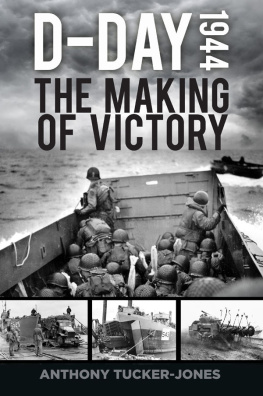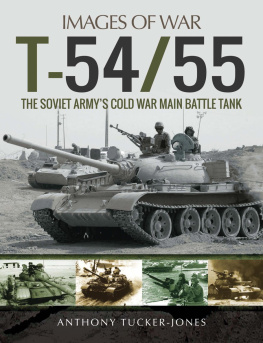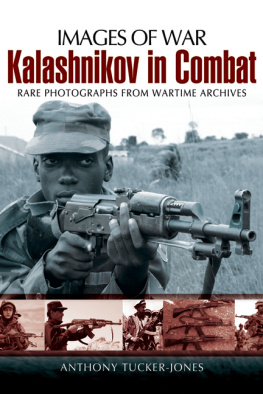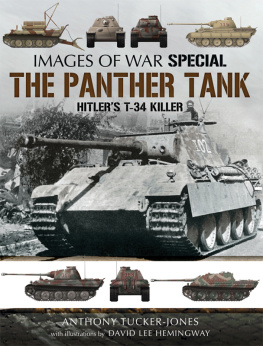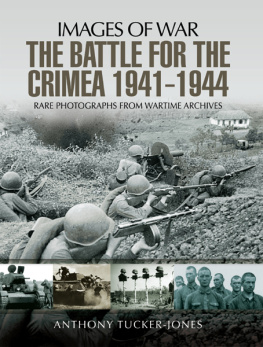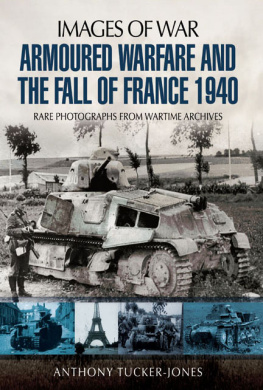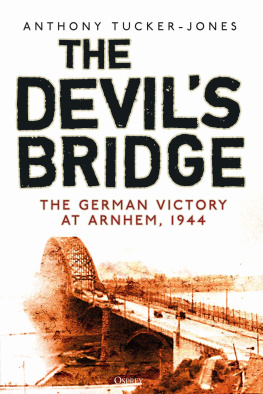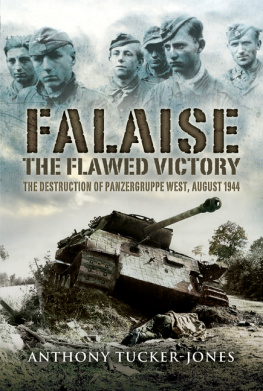Tucker-Jones Anthony - 1944 D-Day
Here you can read online Tucker-Jones Anthony - 1944 D-Day full text of the book (entire story) in english for free. Download pdf and epub, get meaning, cover and reviews about this ebook. year: 2019, publisher: The History Press, genre: Non-fiction. Description of the work, (preface) as well as reviews are available. Best literature library LitArk.com created for fans of good reading and offers a wide selection of genres:
Romance novel
Science fiction
Adventure
Detective
Science
History
Home and family
Prose
Art
Politics
Computer
Non-fiction
Religion
Business
Children
Humor
Choose a favorite category and find really read worthwhile books. Enjoy immersion in the world of imagination, feel the emotions of the characters or learn something new for yourself, make an fascinating discovery.
- Book:1944 D-Day
- Author:
- Publisher:The History Press
- Genre:
- Year:2019
- Rating:3 / 5
- Favourites:Add to favourites
- Your mark:
- 60
- 1
- 2
- 3
- 4
- 5
1944 D-Day: summary, description and annotation
We offer to read an annotation, description, summary or preface (depends on what the author of the book "1944 D-Day" wrote himself). If you haven't found the necessary information about the book — write in the comments, we will try to find it.
1944 D-Day — read online for free the complete book (whole text) full work
Below is the text of the book, divided by pages. System saving the place of the last page read, allows you to conveniently read the book "1944 D-Day" online for free, without having to search again every time where you left off. Put a bookmark, and you can go to the page where you finished reading at any time.
Font size:
Interval:
Bookmark:

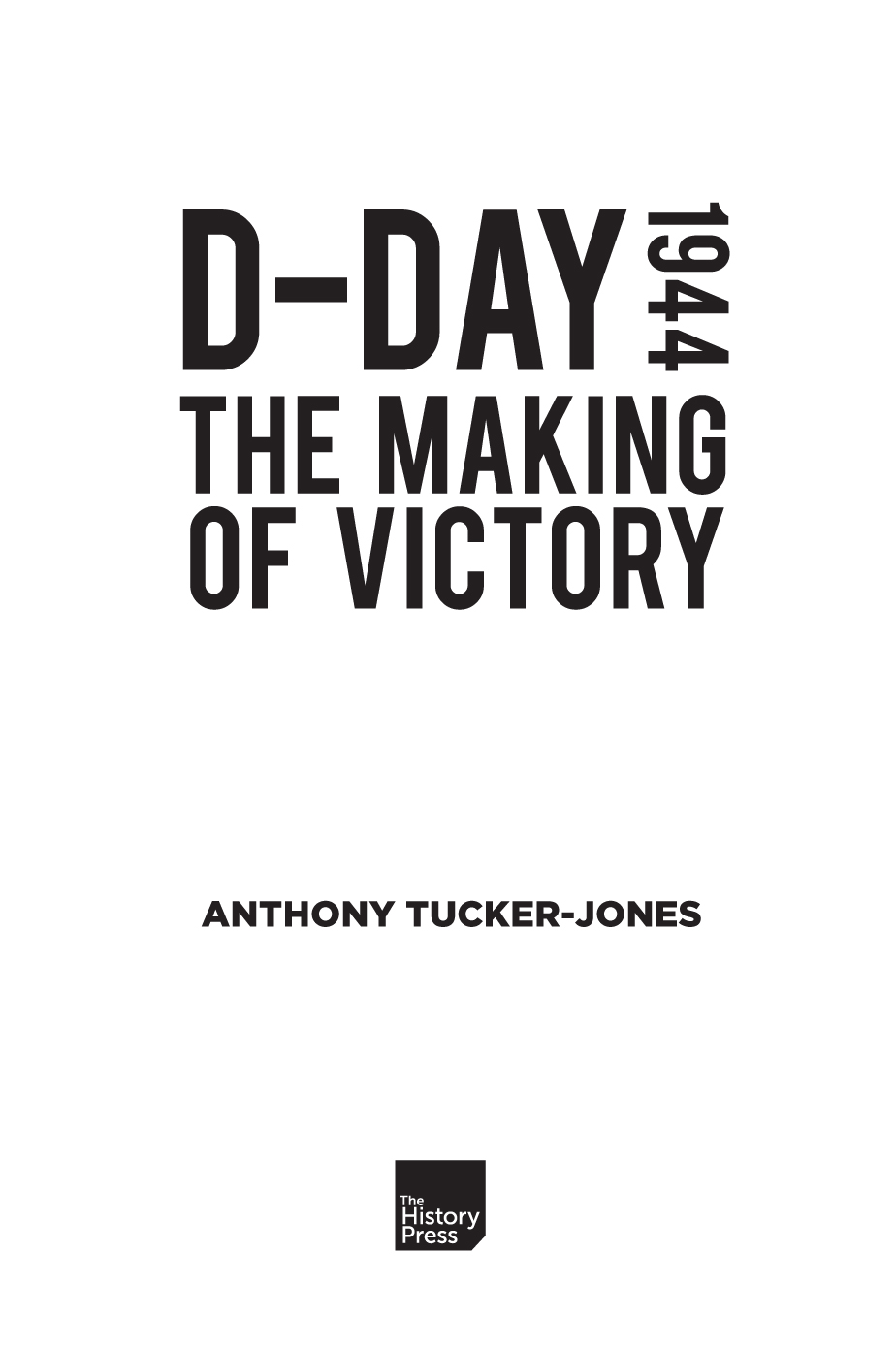
First published 2019
The History Press
The Mill, Brimscombe Port
Stroud, Gloucestershire, GL5 2QG
www.thehistorypress.co.uk
Anthony Tucker-Jones, 2019
The right of Anthony Tucker-Jones to be identified as the Author of this work has been asserted in accordance with the Copyright, Designs and Patents Act 1988.
All rights reserved. No part of this book may be reprinted or reproduced or utilised in any form or by any electronic, mechanical or other means, now known or hereafter invented, including photocopying and recording, or in any information storage or retrieval system, without the permission in writing from the Publishers.
British Library Cataloguing in Publication Data.
A catalogue record for this book is available from the British Library.
ISBN 978 0 7509 9173 5
Typesetting and origination by The History Press
Printed and bound in Great Britain by TJ International Ltd
eBook converted by Geethik Technologies
The roar of the powerful engines was deafening as the flat-nosed landing craft bludgeoned its way through the choppy waves. On every drop the vessel and its occupants were deluged in fine spray. The overriding smell was of diesel, oil and brine. For delicate stomachs, this and the constant motion was not a good combination. Trying to ignore these conditions, the Royal Marines slithered over their rocking tank carrying out vital last-minute checks. At sea, the five-man crew travelled on the outside just in case of mishap with their struggling vessel.
Every vehicle involved in Operation Overlord on 6 June 1944 had been plastered in a greasy, putty-like substance called Compound 219. This was jammed into all crevices and openings in a desperate effort to keep out seawater when the vehicle waded ashore. On tanks the turret ring and gun muzzle were also sealed with a type of plastic covering. Tankers did not greatly mind the application of the compound as they spent most of their time covered in grease and oil anyway. Seawater, on the other hand, was not welcome as it played havoc with the electrics and the engine. At over 60 tons, no amount of grease would make the Centaur float in deep water.
The Marines were working on their Centaur tank, of which almost a thousand had been built. However, this was specially designed for close support and one of less than 100 armed with a 95mm howitzer destined to see action on D-Day. It was a bunker-buster that could smash open concrete at close range. The driver and co-driver gave the Nuffield-built up-rated Liberty engine one last going over. If it failed to start or stalled when the landing craft ramp went down, then there would be hell to pay.
Although its official speed was about 27mph, with a bit of doctoring it was possible to manage almost twice that. If the driver had his way, he was going to sprint up the beach at full speed, assuming that the obstacles and mines had been cleared by the engineers and the Funnies. The crew had dubbed their tank Hunter, and its turret was marked in white with the degrees of the compass in order to bring all the guns of the troop to bear on a target as quickly as possible. The centaur of ancient Greek mythology, half-man half-horse, was often depicted with a bow in its hands, so Hunter seemed highly appropriate.
The men, swerving with H Troop, 2nd Battery, 1st Royal Marine Armoured Support Regiment were heading for a beach in Normandy codenamed Gold. Their orders appeared simple enough: provide covering fire from their landing craft, and once they were ashore continue to assist the assaulting infantry and commandos. They had fifty-one rounds for their turret-mounted howitzer, so it was vital they made every shot count.
Amongst the Centaur crews being buffeted by the waves was George Collard. He felt that they looked suitably nautical with their ration boxes and naval hammocks lashed up behind the turret. Also, on the way over, a naval rating had taken pity on one of the crew and loaned them a waterproof oilskin coat that was much more weather-resistant than the sleeveless leather jerkins worn by some of the crews over their overalls, which dated back to the First World War. Looking out to sea, a smile came over his face as he remembered how, earlier in the year, they had pranged the tank before it had even seen combat.
Collards unit had decamped from Corsham to the estate of Lord Mountbatten near Romsey in Hampshire ready for D-Day. Going through Devizes they had suffered a mishap. Our tank, driven by a three-badge Royal artilleryman, he recalled, left the road and promptly crashed through the wall. The latter was inevitably a write-off, while the tank barely suffered a scratch. Besides, no one cared if the front mudguards got ripped off. It was a funny incident that resulted in much swearing by the troop commander, but such accidents were commonplace. Now, though, was the time to put all their training into practice. Lieutenant-Colonel Peskett, Collards regimental commander, had pushed them hard, and for good reason.
During the night, the crossing had not been pleasant for the Centaur crews, or anyone else for that matter, because of the rough sea. Thanks to the weight of the tanks, the landing craft rode very low in the water. We slung hammocks where we could, sometimes between the tanks, recalled Collard. Many were seasick, including the sailors.
When they neared the French coast, the Marine gunners and loaders clambered back into the turrets. They quickly rammed a high explosive round into the guns breech. No one liked the idea of firing a tank from a moving landing craft least of all the coxswain. The gunners knew they were unlikely to hit anything useful, but their actions added to the general bombardment of the enemy defences nonetheless.
Aboard a tank landing craft, Sub Lieutenant Frank Thomasson, with the Royal Navy Volunteer Reserve, was amazed at how relaxed the Marines were. They had risen early to check their kit and seemed in no haste to disembark. Before marching off they removed their steel helmets, and one man donned a top hat and raised an umbrella. This action by the Marines had a calming effect on all, observed Thomasson.
When Collards troop finally rolled into the sea off Gold Beach, water rushed into the turret ring and his troop sergeant could not get out of his hatch and was soaked. Collard poked his head out the turret and looked with some admiration at the sight of the shells landing on the concrete strongpoints. The Germans were getting a good pasting.
Directing the sodden driver, they managed to successfully negotiate the anti-invasion obstacles, only to have the left track blown off by a mine. A number of wounded and dead were on the beach, noted Collard, including some killed where our own tanks had run over them pushing it appeared the bile in the liver up to their faces. Having reached the cover of the dunes, his crew managed to repair their lame Centaur and get it back into the fight.
When Sergeant John Cleggs Centaur rolled ashore he became aware of an unwelcome noise above the racket of the engine. You can hear possibly bullets, he said, splattering against the side of the landing craft and your tank: pitter-patter, pitter-patter. In response, he and his crew were soon engaging their assigned targets.
Lieutenant-Colonel Peskett had a total of thirty-two Centaurs and eight Sherman tanks with which to support the landings east of Arromanches.
Next pageFont size:
Interval:
Bookmark:
Similar books «1944 D-Day»
Look at similar books to 1944 D-Day. We have selected literature similar in name and meaning in the hope of providing readers with more options to find new, interesting, not yet read works.
Discussion, reviews of the book 1944 D-Day and just readers' own opinions. Leave your comments, write what you think about the work, its meaning or the main characters. Specify what exactly you liked and what you didn't like, and why you think so.

